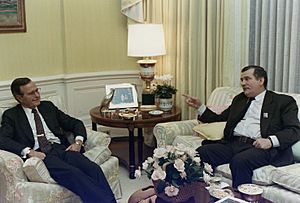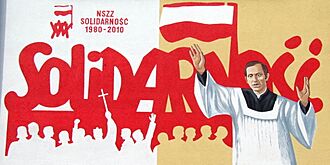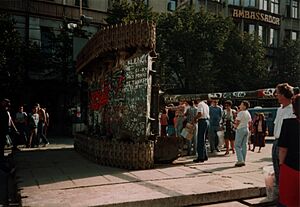Solidarity (Polish trade union) facts for kids
|
Niezależny Samorządny Związek Zawodowy „Solidarność”
|
|

Solidarity logo
|
|
| Founded | 31 August 1980 (recognised) 17 September 1980 (1st Congress) 10 November 1980 (registered) |
|---|---|
| Type | Labour movement |
| Headquarters | Gdańsk, Poland |
| Location |
|
|
Members
|
Almost 10 million at the end of the first year; over 400,000 in 2011 (680,000 in 2010) |
|
Key people
|
Anna Walentynowicz, Lech Wałęsa |
| Website | Solidarnosc.org.pl (in English) |
Solidarity (in Polish: „Solidarność”) is a famous Polish trade union. It was started in August 1980 at the Gdańsk Shipyard in Gdańsk, Poland. It was the first independent trade union in a country controlled by the Soviet Union to be officially recognized by the government.
Solidarity quickly grew, reaching 10 million members by September 1981. This was about one-third of all working people in Poland! In 1983, Solidarity's leader, Lech Wałęsa, won the Nobel Peace Prize. Many people believe Solidarity played a huge part in ending communist rule in Poland. This led to Poland having its first non-communist Prime Minister since the 1940s.
In the 1980s, Solidarity was a big social movement that stood against the government. It used peaceful methods, like protests and strikes, to fight for workers' rights and social change. The government tried to stop Solidarity in the early 1980s by putting the country under military rule and arresting many people.
Even though it was banned, Solidarity continued to work secretly. It received important financial help from the Vatican and the United States. Because of this support, the union survived. In the late 1980s, it began talking with the government again.
These talks, called the round table talks, happened in 1989. They led to the first mostly free elections in Poland since 1947. By the end of August 1989, a government led by Solidarity was formed. In December 1990, Lech Wałęsa was elected President of Poland.
After Poland became a capitalist country in the 1990s, many state-owned businesses were sold to private companies. Solidarity's membership went down a lot. By 2010, 30 years after it started, the union had lost more than 90% of its original members.
Contents
How Solidarity Began
In the 1970s, the Polish government raised food prices, but people's wages stayed the same. This caused many problems and led to protests in 1976. The government responded by cracking down on anyone who disagreed with them. Groups like the KOR and the ROPCIO started working secretly to watch the government and oppose its actions. Trade unions were a key part of these secret groups.
By 1979, Poland's economy was shrinking for the first time since World War II. The country's foreign debt reached about $18 billion by 1980.
A worker named Anna Walentynowicz was fired from the Gdańsk Shipyard on August 7, 1980. She was fired because she was involved in an illegal trade union, and she was only five months away from retirement. This made the shipyard workers very angry. They started a strike on August 14 to support Walentynowicz and demand her job back. Anna Walentynowicz and Alina Pienkowska helped turn this strike, which started over simple issues, into a bigger "solidarity strike" to support other strikes happening nearby.
Solidarity officially began on August 31, 1980, at the Gdańsk Shipyard. This happened when the Communist government of Poland signed an agreement allowing the union to exist. On September 17, 1980, more than twenty groups of independent trade unions joined together to form one national organization, NSZZ Solidarność (Solidarity). It was officially registered on November 10, 1980.
Lech Wałęsa and others created a large movement against the Soviet system. This movement included people from the Catholic Church and those on the anti-Soviet left. Polish pride and a pro-American attitude were also important in how Solidarity grew in the 1980s. Solidarity always promoted peaceful actions among its members.
In September 1981, Solidarity held its first national meeting. They elected Wałęsa as president and adopted a plan for a "Self-governing Republic." The government tried to destroy the union with military rule in 1981 and several years of harsh actions. But in the end, the government had to start talking with Solidarity.
Negotiations and New Government
The Roundtable Talks took place from February 6 to April 5, 1989. These talks between the government and the Solidarity-led opposition led to mostly free elections on June 4, 1989. By the end of August, a government led by Solidarity was formed, and Tadeusz Mazowiecki became the Prime Minister. In December 1990, Wałęsa was elected President of Poland. He then stepped down as the head of the union.
After 1989, Solidarity became more like a traditional trade union. It had less direct influence on Polish politics in the early 1990s. A political group called Solidarity Electoral Action (AWS) was founded in 1996. It won the parliamentary election in 1997 but lost the next one in 2001. In the years that followed, Solidarity had less impact on Polish politics.
Support from Other Countries

The Reagan Administration in the United States supported the Solidarity movement. They ran a public campaign to prevent what they saw as a possible invasion of Poland by Soviet forces. The Central Intelligence Agency (CIA) secretly sent about $2 million each year to Solidarity starting in 1982. Over five years, this totaled $10 million. The money was sent through other groups, not directly from the CIA to Solidarity leaders.
The AFL–CIO, a labor union in the U.S., also raised $300,000 from its members. This money was given directly to Solidarity to help them. The U.S. Congress also created the National Endowment for Democracy to promote democracy, and it gave $10 million to Solidarity.
The Polish government declared martial law in December 1981, but Solidarity was not warned beforehand. Some people think the CIA was surprised, while others believe U.S. leaders thought an internal crackdown was better than a Soviet invasion. The CIA's support for Solidarity included money, equipment, and training. Henry Hyde, a U.S. House intelligence committee member, said the USA provided "supplies and technical assistance in terms of secret newspapers, broadcasting, propaganda, money, organizational help and advice."
Solidarity and the Catholic Church

Solidarity has had strong ties with the Catholic Church. In 2017, Solidarity supported a plan to ban most shopping on Sundays, which was also supported by Polish bishops. A new Polish law banning almost all trade on Sundays took effect in 2018. This was the first time large supermarkets and most other stores were closed on Sundays since shopping laws became more open in the 1990s. The Law and Justice party passed this law with support from Prime Minister Mateusz Morawiecki.
Lech Wałęsa has said that Pope John Paul II played a very important role in the creation of Solidarity. The Pope, who was from Poland, visited his home country in 1979. He was a figure that Polish citizens could relate to, and he was beyond the control of the Communist government. Many world leaders, including Wałęsa, believe that Pope John Paul II's actions helped bring down not only the Polish communist government but also communism across Europe.
Solidarity's Impact Around the World

Solidarity's survival was a unique event, not just in Poland, which was a country controlled by the USSR, but across the entire Eastern bloc. It showed a change in the strict approach of the Communist government in Poland. Earlier, the government had violently stopped protests in 1970, and the Soviet government had crushed uprisings in Hungary (1956) and Czechoslovakia (1968) with invasions.
Solidarity's success helped spread anti-Communist ideas and movements throughout the Eastern Bloc countries. This weakened their Communist governments. The Round Table Agreement between the Polish government and Solidarity led to elections in Poland on June 4, 1989. In these elections, the opposition was allowed to run against the Communist party. These were the first free elections in any Soviet bloc country.
Solidarity won almost all the seats it could in the new Polish parliament. This victory started a chain reaction across the Soviet Union's satellite states. It led to mostly peaceful anti-communist events in Central and Eastern Europe known as the Revolutions of 1989. These events ended with the overthrow of each Moscow-controlled government and eventually led to the dissolution of the Soviet Union in the early 1990s.
Because Solidarity received support from many Western governments, its relationships with trade unions in capitalist countries could be tricky. For example, during the UK miners' strike in 1984–85, Wałęsa said that miners should fight smartly, not with destruction. He also praised British Prime Minister Margaret Thatcher. However, David Jastrzębski, the president of Upper Silesia Solidarity, supported the striking miners. He said that neither the British government's police actions nor the Polish government's tanks could break their shared will to fight for a better future for workers. This was despite the fact that Arthur Scargill, the leader of the British miners' union, had criticized Solidarity as an "anti-socialist organization."
In late 2008, several groups in Russia that supported democracy formed a movement called Solidarity. In the United States, a political party called the American Solidarity Party was named after the original Polish Solidarity.
How Solidarity is Organized
Solidarity was officially founded on September 17, 1980. Its main power was held by a group called the Convention of Delegates. The daily operations were managed by the National Coordinating Commission, later called the National Commission. The union was organized by regions, with 38 regions and two districts. At its peak, Solidarity had over 10 million members, making it the largest union in the world.
During the Communist era, when martial law began on December 13, 1981, many regional leaders of the union were arrested and jailed. After a year in prison, high-ranking members were offered one-way trips to any country that would accept them, such as Canada, the United States, or countries in the Middle East.
Solidarity was set up as an "industrial union." This means that workers in all different jobs within a region were organized together, rather than by their specific trade.
In 2010, Solidarity had more than 400,000 members. The National Commission of the Independent Self-Governing Trade Union is located in Gdańsk. It is made up of delegates from regional meetings.
Solidarity's Regional Offices
Solidarity is divided into 37 regions. These regions mostly follow the old administrative divisions of Poland from 1975 to 1998. The regions include:
- Gdańsk, based in Gdańsk
- Warmia-Masuria, based in Olsztyn
- Elbląg, based in Elbląg
- Lower Silesia, based in Wrocław
- Pila, based in Piła
- Western Pomerania, based in Szczecin
- Land of Łódź, based in Łódź
- Częstochowa, based in Częstochowa
- Land of Sandomierz, based in Stalowa Wola
- Płock-Kutno, based in Płock
- Lesser Poland, based in Kraków
- Opole Silesia, based in Opole
- Seashore, based in Koszalin
- Słupsk, based in Słupsk
- Zielona Góra, based in Zielona Góra
- Podbeskidzie, based in Bielsko-Biała
- Konin, based in Konin
- Southern Greater Poland, based in Kalisz
- Podlachia, based in Białystok
- Piotrków, based in Piotrków Trybunalski
- Cuiavia and Dobrzyń Land, based in Włocławek
- Carpathia, based in Krosno
- Land of Rzeszów, based in Rzeszów
- Toruń, based in Toruń
- Silesia-Zaglebie, based in Katowice
- Land of Radom, based in Radom
- Greater Poland, based in Poznań
- Gorzów, based in Gorzów Wielkopolski
- Holy Cross, based in Kielce
- Middle-East, based in Lublin
- Bydgoszcz, based in Bydgoszcz
- Jelenia Góra, based in Jelenia Góra
- Leszno, based in Leszno
- Chełm, based in Chełm
- Przemyśl-Jarosław, based in Przemyśl
- Mazovia, based in Warsaw
- Copper Basin, based in Legnica
Leaders of Solidarity
- Lech Wałęsa (1980–1991)
- Marian Krzaklewski (1991–2002)
- Janusz Śniadek (2002–2010)
- Piotr Duda (2010–present)
Images for kids
See also
 In Spanish: Solidaridad (Polonia) para niños
In Spanish: Solidaridad (Polonia) para niños




